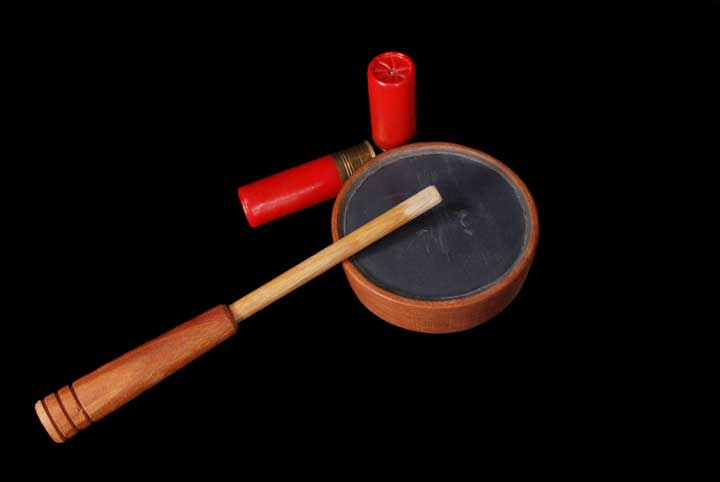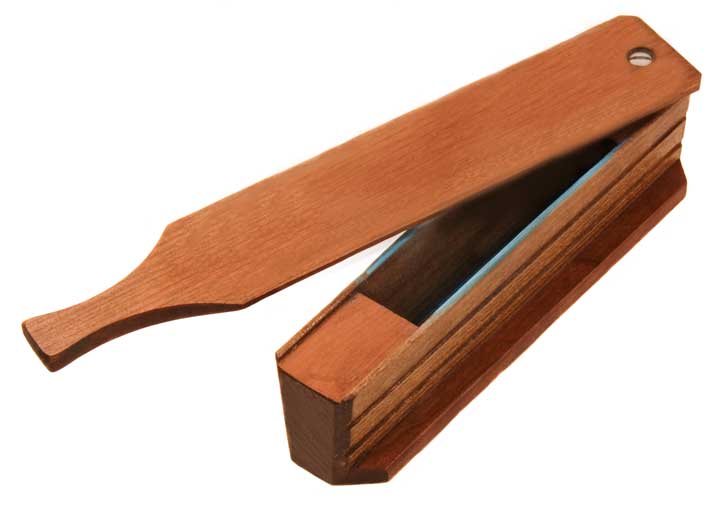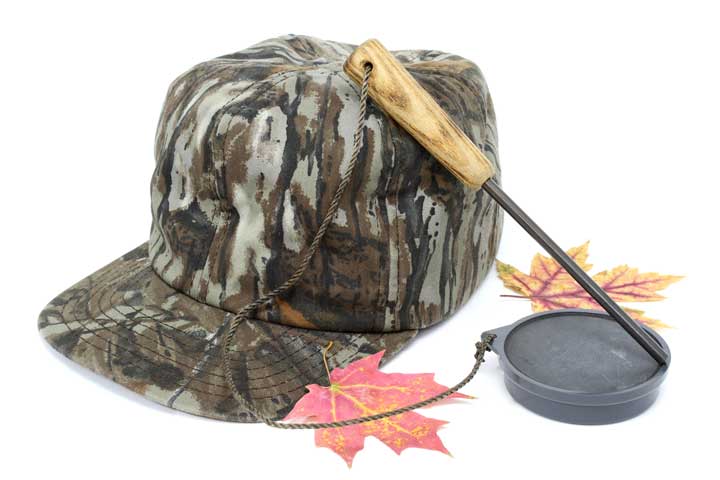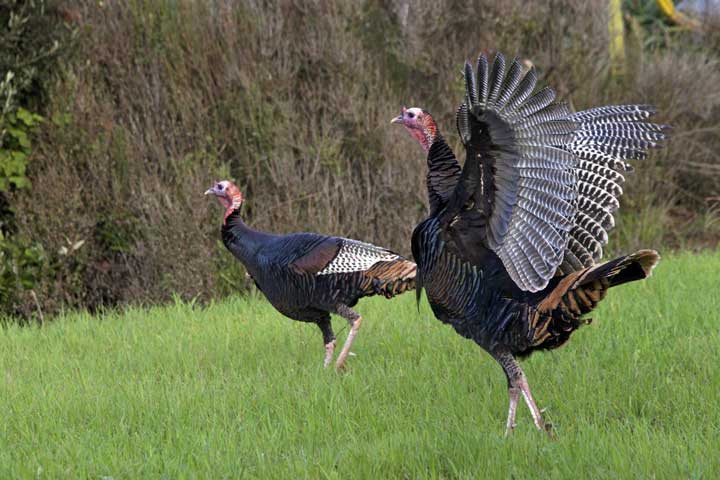There’s no sweeter sound to a hunter’s ear than a gobbling turkey. During mating season, turkeys become more vocal, which makes them susceptible to calling tactics.
When I’m out hunting turkeys, I’ve found few better ways to attract my quarry than calling. While calling isn’t necessarily required during a turkey hunt, it can help you to bag more birds without scaring any away.
Here, I’m going to go over how to call turkeys to improve your success on your next hunt.
How Do You Get a Turkey to Come to You?
Turkeys are skittish birds, and trying to pursue them will often result in you coming home empty-handed, especially considering how fast they can run. Instead, a sit-and-wait approach is often best.
Rafters of turkeys tend to gather around a single spot each morning, most commonly known as a roost tree. It’s a good idea to set up a little ways off from the roost tree along a travel route or near a favorite feeding spot.
You should give yourself plenty of visibility and a wide shooting lane. Just try to avoid setting up near any nests, as it’s important to preserve turkey eggs to keep numbers high.
Even if you have yourself situated in the perfect spot, you may still have trouble bagging a bird. While it can be tempting to try chasing after a gobbler, this is likely to scare away all nearby game.
Instead, you can lure a turkey to you by using a convincing turkey call. Toms gravitate towards the clucks and yelps of hens, especially during mating season in the springtime.
By mimicking a hen, you can convince a tom to fly down and come looking for some love. If he gobbles back at you, that means that he’s accepted your calls as a fellow turkey.
When a tom fails to gobble back, don’t worry. Try clucking just a little bit louder to capture his attention. Once you’ve caught his attention, quiet down and wait for your quarry to come within easy shooting range.

How Do You Call a Turkey When Hunting?
Turkey calling is a surefire way to improve your success while out on a hunt. However, calling can be a difficult talent to master, even for experienced hunters. You should familiarize yourself with all of the most common calls and vocalizations that will help you to attract a prize tom.
What Is the Best Sound to Call in a Turkey?
Turkeys make a wide variety of different sounds that you can mimic. Using certain calls may give you better results depending on the area, the time of day, and the bird in question.
- Assembly Call
- Cutt
- Putt
- Excited Yelp
- Cluck and Purr
- Cackle
- Gobble
- Kee-kee Run
What Do You Say When Calling Turkeys?
A multi-tool, also known as a diaphragm call, is one of the most popular ways to call a turkey. Using your own voice to attract birds is a convenient and versatile option. It keeps your hands free for your bow or firearm, and it’s always readily available.
Unfortunately, mouth calls are also incredibly difficult to master. It takes plenty of practice and patience to perfect a call that will convince a turkey.
You’ll need small, specialized reeds placed in the mouth to produce a realistic turkey noise. You can use between one and three reeds to produce sound depending on your chosen method. For beginners, a two-reed call is often the easiest option.
Your reeds should be moist and positioned forwards, pressing against the roof of your mouth. Using your diaphragm, produce a slow, steady stream of air from deep within the gut. This will vibrate the reeds, creating a whistling noise.
You can adjust the position of your tongue to change pitch and tone to match the sound of a turkey call. Using a mouth call, you can recreate common vocalizations.
Some of the best to use include the two-tone yelp, a kee-kee run, a cutt, or a simple cluck. Some talented callers have even managed to master the vibrations of a turkey purr.
How Do You Call a Turkey in a Box Call?
Beginners may find it easier to call turkeys using specially designed apparatus such as a box call. While this method isn’t quite as convenient as a mouth call, it’s easier and more consistent for hunters of all skill levels.
A box call consists of either a wooden or metal paddle attached to a hollow box, usually made of wood or plastic. By moving the paddle, you can create different vibrations that mimic calls such as gobbles and clucks.

How Do You Call a Turkey in a Pot Call?
A pot call is similar to a box call in that it uses a specialized device to produce turkey sounds. Pot calls, or slate calls, are just as easy to use and give you more control over factors such as volume.
A pot call is a small, round device known as a pot with a hard surface made of glass, slate, or metal. It includes a wooden striker designed to hit this surface and create an authentic turkey sound. How hard you strike determines how loud your call will be.

If you want to produce different calls, you can find specialized strikers for your pot. They come in different styles and use different types of wood to produce calls ranging from soft clucks to loud gobbles.
How Do You Blind Call a Turkey?
Plenty of hunters rely on blind calling to bring turkeys in their direction. Unfortunately, there’s a common misconception that blind calls have to be soft and subtle to work.
While turkeys do make quiet noises, they only tend to do it at close range. A lone turkey searching for its flock will make much louder noises. It’s in distress and trying to call loud and often enough for its flock to hear, often with a string of yelps.
While it’s fine to start out subtle, you may want to amp up your tactics if you’re not getting a response. Don’t be afraid to get louder and more persistent. Toms are much more likely to hear and respond to your blind call, even from a distance.
Why Do Turkeys Gobble Back at You?
In the turkey world, only mature toms can gobble. They often do it around mating season in the spring, but you can also hear turkeys gobbling as they roost.
Gobbling is a mating call designed to attract hens. When you hear a tom gobbling, it’s because he believes that there are hens nearby to attract.
If you’ve ever gobbled at a tom, either in the wild or in captivity, there’s a good chance that he gobbled right back at you. This isn’t necessarily because he views you as a potential mate, however.
Turkeys have a shock gobble response when they hear loud noises. If you gobble at a tom, the gobble that he gives in return is instinctual.
You can use this technique in the same way that you can use a blind call. A shock gobble can give away the location of a hidden tom, even without a proper mouth, box, or pot call.
How Far Will Turkeys Come to a Call?
If you’ve ever heard a wild turkey at close range, you know that these birds can be almost impossibly loud. Turkeys attract mates from a distance, and toms are often willing to travel for a chance at a fertile hen.
If you’re calling a turkey, you can expect to attract birds from hundreds of yards away. With a loud enough call, you may even capture the attention of birds as far as 1,000 yards away.
For the best chance of success, however, it’s best to set up within a couple of hundred yards of your prize.
Why Don’t Turkeys Come to My Calls?
Unfortunately, calling isn’t always a foolproof method for attracting a bird. There are a number of different reasons a turkey might not come to your call:
- Your tone or rhythm is off
- You’re calling too quietly
- You don’t sound authentic
- You’re too far away
- You spooked the flock
- It’s the wrong time of day
What Is the Best Time of Day to Hunt Turkeys?
Most hunters prefer to go after turkeys first thing in the morning. Turkeys tend to roost in trees or on the ground overnight, arising around dawn in search of breakfast.
Mornings are often when turkeys are most vocal and most active. As a hunter, it’s easiest to find roosts and attract toms in the early morning. Turkeys are more likely to respond to calls, as they tend to be more cautious as evening approaches.
What Time of Day Do Turkeys Gobble?
Turkeys can be unpredictable in their gobbling. Some days, toms chatter from dawn until dusk, while other days see barely a peep from local flocks.
In general, however, you can expect turkeys to gobble most as they wake up in the morning. Toms may even begin to gobble before first light if they hear any loud or startling noises. As night approaches, turkeys become quieter.
When Should I Call Turkeys When Hunting?
It’s best to call turkeys when they’re feeling their most vocal. It shows that they’re comfortable in their surroundings and not necessarily on the lookout for predators. If possible, try to call turkeys in the early morning, as toms are more likely to respond.
How Do You Call a Turkey in the Morning?
If you know where nearby turkeys roost, quietly sneak out and set up before first light. Once you hear the flock waking and becoming active, you can start making soft calls. If you don’t get a response at first, stay still and call slightly louder to attract the attention of a tom.
Can You Sneak up on a Turkey?
Unlike other prey animals, it’s virtually impossible to sneak up on a turkey. They have excellent eyesight, and flocks often have a lookout to warn of danger.
If you hear a tom gobbling, stay put and wait for him to come to you. If you try chasing after him, you’re likely to spook the bird. There’s also a chance that you could stumble upon another unsuspecting hunter. Instead, it’s best to rely on calls to attract prie turkeys.
Will Turkeys Come Back if You Spook Them?
Many hunters believe that if a turkey spots you, the hunt is over. Fortunately, this isn’t always the case. If you spook a bird, it doesn’t mean that it’s going to flee the area.
Often, scared toms will simply hunker down and keep quiet until they think the danger has passed. If you wait long enough, you’re likely to see a spooked turkey return.

What to Do if a Turkey Sees You?
If a turkey spots you, don’t worry. You may have to regroup and find a better hiding spot, but you haven’t necessarily scared the bird away.
Give your quarry some time to calm down again. Switching position and switching calls are some of the best ways to attract a previously spooked bird.
In Conclusion
When I’m out hunting turkeys, I’ve found calling to be one surefire way to bag my prize. Instead of going on a wild goose chase, you can lure a turkey to your position to get the perfect shot.
If you know when, where, and how to call a turkey, you’re bound to improve your success on your next hunt.




